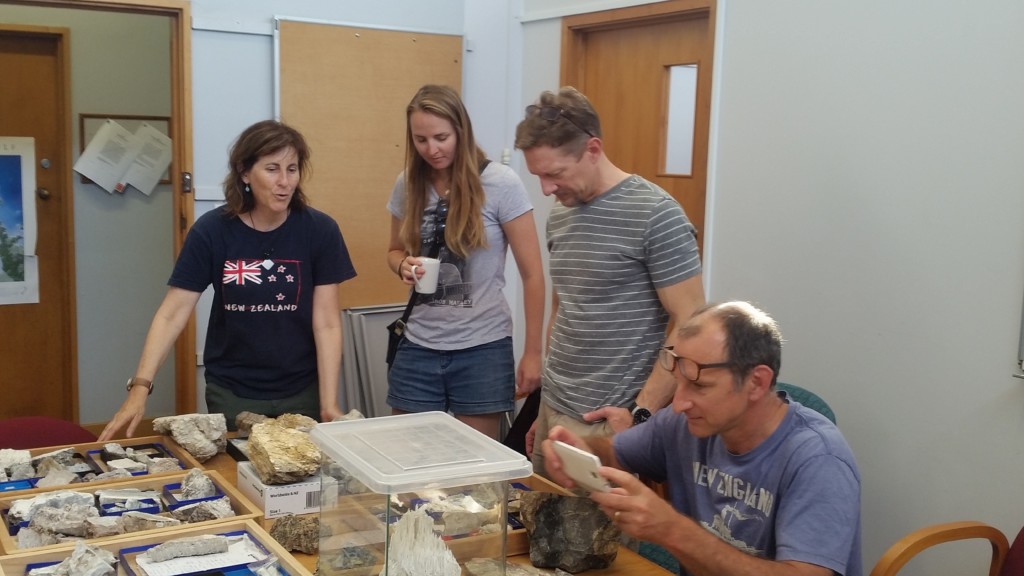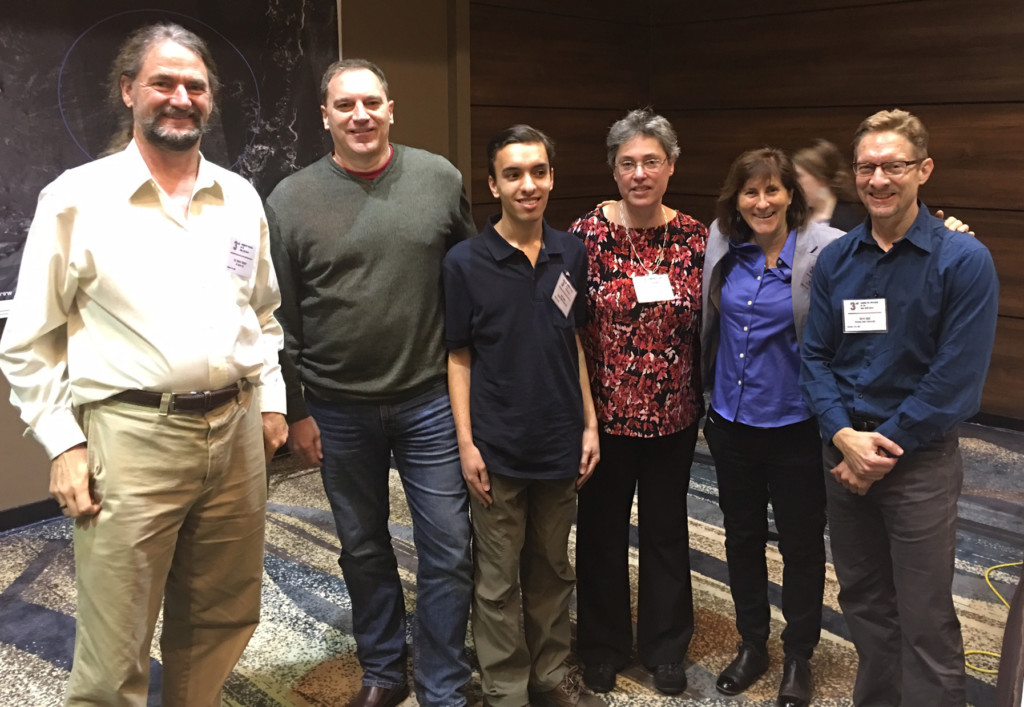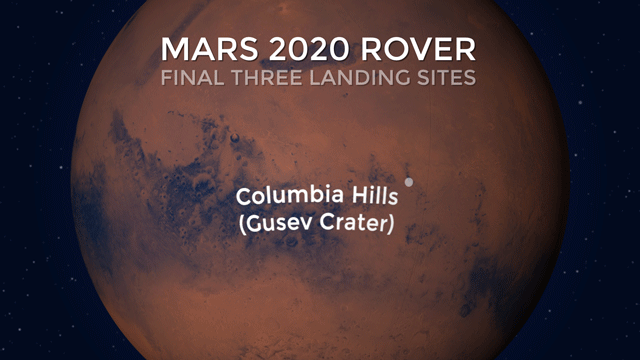A team, including Professor Kathy Campbell, attended a workshop sponsored by NASA and JPL on 8-10 February 2017 in Monrovia, California, where 250 scientists and engineers discussed where the next Mars rover, launching in 2020, should land. Kathy’s team presented arguments for one of the 8 remaining landing sites that were still under consideration – at Columbia Hills in Gusev Crater – and were successful in making it into the Final 3. Choice of The One will happen at the 4th Mars 2020 landing site meeting planned for 2018.

This approximate true-color image taken by the Mars Exploration Rover Spirit shows a rock outcrop dubbed “Longhorn,” and behind it, the sweeping plains of Gusev Crater. On the horizon, the rim of Gusev Crater is clearly visible. The view is to the south of the rover’s current position. The image consists of four frames taken by the 750-, 530- and 430-nanometer filters of Spirit’s panoramic camera on sol 210 (August 5, 2004). IMAGE CREDIT: NASA/JPL-CALTECH/CORNELL
How did you get involved with the landing site team proposal?

Steve and Kathy in the field in Rotorua area, 2016
I had been working with Archean astrobiologists since 2014, exploring the link between early life habitats on Earth and the hot springs that I study (Jurassic-modern) in different parts of the world, including New Zealand. One of the Spirit rover team geologists, Dr. Steve Ruff, a proponent of the Home Plate (Columbia Hills) silica site on Mars having been formed by an ancient siliceous hot spring, came along on a geothermal field trip I led in February 2016 to the Rotorua area with Australian geologists who work on Archean rocks. On the field trip and from our extensive rock collection, we compared modern to Miocene age (0-20 million years old) hot springs in New Zealand with ~3.5 billion year old deposits in Western Australia, and we also discussed parallels with some unusual knobby silica deposits at Columbia Hills and other hot spring sinters at El Tatio, Chile, and in the Taupo Volcanic Zone. The idea that we should all come along to the 3rd Mars 2020 Landing Site Workshop to discuss our research came out of that fruitful NZ field trip last year.

Kathy Campbell is showing the group her research rock collection and discussing similarities with Archean and Columbia Hills siliceous rocks.
Who is your team?
Steve Ruff (planetary geologist, Arizona State University), Jim Rice (geomorphology of Mars and expression of water shaping the planet’s surface, Planetary Science Institute), Hanna Nekvasil (volcanologist and planetary geologist, New York State University at Stonybrook), Martin Van Kranendonk (Archean geology and astrobiology, University of New South Wales), Bruce Damer (prebiotic chemist, University of California at Santa Cruz), Alex Longo (Columbia Hills enthusiast, high school student).

What was Martin Van Kranendonk’s role at the workshop?

Martin Van Kranendonk
While the others presented aspects of Mars geology and Earth analogues for the Columbia Hills site, Martin gave an overview talk earlier in the workshop explaining the importance of Archean environments on Earth in narrowing the search for possible ancient life on Mars. He noted the importance of silica as a preserving mineral in most Archean deposits (some originally carbonate and some originally silica) to produce high-quality, very old fossils found here on Earth. The Columbia Hills site is nearly pure silica and has a close spectral match to siliceous hot spring deposits (sinter) from the high-elevation, Mars-analogue geothermal system at El Tatio in Chile.
What is the link between early life in Western Australia and possible life on Mars?
My research group, led by Martin Van Kranendonk and his PhD student Tara Djokic, have been studying and describing this link. 3.48 billion year old siliceous rocks of the Dresser Formation, Pilbara craton, Western Australia, preserve evidence for having formed in hot springs on land — the earliest life on land yet known, and about the same age as when life may have been present on Mars (a wetter time in its past, with heating from once active volcanoes and bolide impacts). Some key comparisons can be made between textures and microbes of younger New Zealand hot springs and features preserved in the Dresser Formation rocks, which we interpret as sinters that formed in a very ancient volcanic caldera.
I can see why Australia is important, but you were representing New Zealand … where is the link to Mars from Aotearoa?
New Zealand is full of extreme environments with extremophile microbes that may help us understand the limits of life and its origins, when Earth was a far less hospitable place. In the greater NZ region, we have undersea hot springs (hydrothermal vents of the Kermadecs), marine hydrocarbon seeps and gas hydrates (offshore eastern North Island – possible analogues for oceans on Icy Worlds), and terrestrial (on land) hot springs in the Taupo Volcanic Zone and elsewhere around the country. These places contain extreme life – ecosystems based on chemosynthesis rather than photosynthesis – that help us imagine what life might be/may have been like elsewhere in the Solar System, and even perhaps further afield. And NZ has a geological record of some of these features back to the Cretaceous in some cases. So it is a good place to study analogous environments for when life originated, and in places that are habitable beyond Earth despite their hot, cold, salty, high pressure, acidic, alkaline, etc. nature. NZ is a great place for research into extreme environments, past and present, and for reaching out to youth and the public in varied educational opportunities like NASA’s Spaceward Bound program.
You ended up in the final 3 – what are the other sites like and why do you think yours has ranked as a top candidate?
One of the landing sites, Jezero crater, contains a paleo-delta, where proponents believe organic matter (if ever present on Mars) could have been concentrated out on the toe (low energy) part of the delta, which emptied into an ancient lake. NE Syrtis is an impact crater that may have hosted hydrothermal activity for some time in the distant past. Our proposed landing site at Columbia Hills has been visited by Spirit rover, and thus much is already known about the area and time will be saved going back, especially since the 2020 mission will target biosignatures – in this case the knobby white silica features that Spirit found – and cache samples for a possible future mission to retrieve them. More analytical work in Earth laboratories is required to confirm the origin of these deposits, which in hot springs on Earth are replete with microbes.

What’s next?
The three landing site candidate teams, including ours, have their work cut out for them in the next 1.5 years. Much more orbital information on geology, traverse terrain information and more needs to be collected for each. Shoring up cases for biosignatures and paleoenvironmental settings, including comparative studies with Earth analogue samples using the 2020 instruments, as well as better constraining the age of the deposits (within the early Mars window of wet surface environments), are all tasks ahead. It is an awesome responsibility to have a landing site considered for a Mars mission that will cost $U.S.2.4 billion. People want the best possible candidate site chosen to give us the best chance of finding fossil life on the Red Planet. Who knows … maybe one day humans will be collecting samples from these and other habitable environments on Mars.
More links
Nature: Three sites where NASA might retrieve its first Mars rock: Agency narrows possible targets for the first-ever sample return from the red planet.
Space.Com: Should NASA’s Next Mars Rover Tread New Ground?

